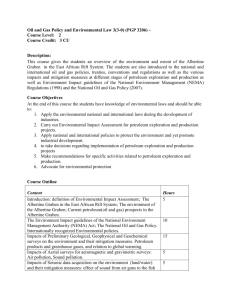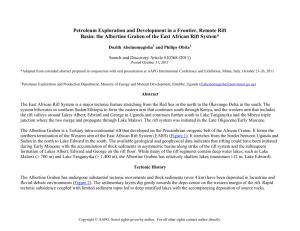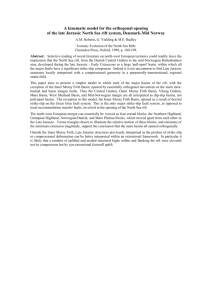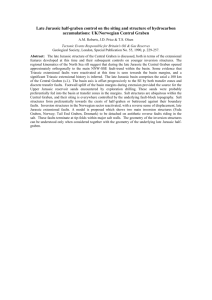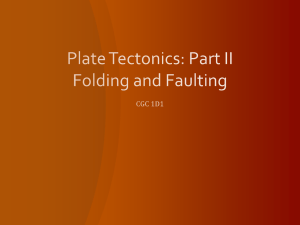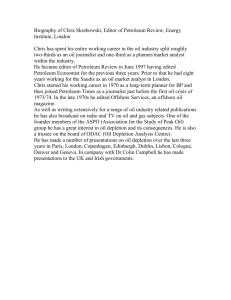existence of a petroleum system
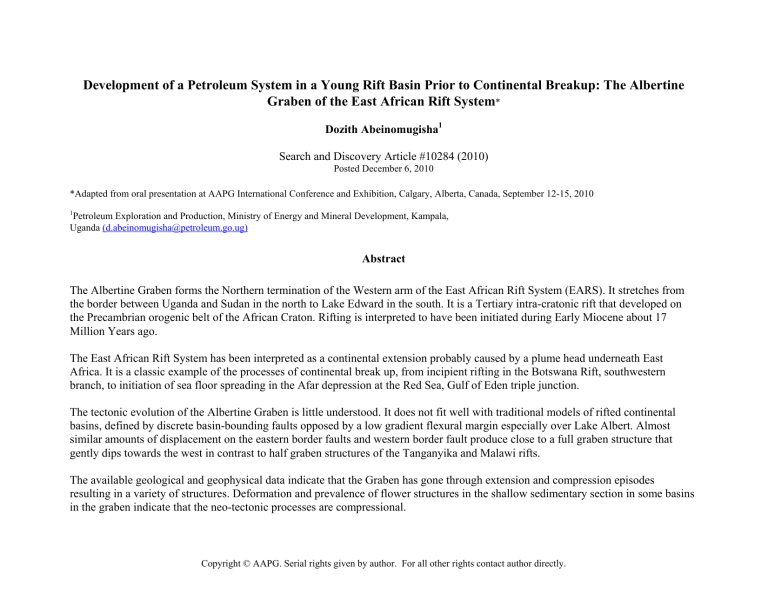
Development of a Petroleum System in a Young Rift Basin Prior to Continental Breakup: The Albertine
Graben of the East African Rift System
*
Dozith Abeinomugisha
1
Search and Discovery Article #10284 (2010)
Posted December 6, 2010
*Adapted from oral presentation at AAPG International Conference and Exhibition, Calgary, Alberta, Canada, September 12-15, 2010
1
Petroleum Exploration and Production, Ministry of Energy and Mineral Development, Kampala,
Uganda (d.abeinomugisha@petroleum.go.ug)
Abstract
The Albertine Graben forms the Northern termination of the Western arm of the East African Rift System (EARS). It stretches from the border between Uganda and Sudan in the north to Lake Edward in the south. It is a Tertiary intra-cratonic rift that developed on the Precambrian orogenic belt of the African Craton. Rifting is interpreted to have been initiated during Early Miocene about 17
Million Years ago.
The East African Rift System has been interpreted as a continental extension probably caused by a plume head underneath East
Africa. It is a classic example of the processes of continental break up, from incipient rifting in the Botswana Rift, southwestern branch, to initiation of sea floor spreading in the Afar depression at the Red Sea, Gulf of Eden triple junction.
The tectonic evolution of the Albertine Graben is little understood. It does not fit well with traditional models of rifted continental basins, defined by discrete basin-bounding faults opposed by a low gradient flexural margin especially over Lake Albert. Almost similar amounts of displacement on the eastern border faults and western border fault produce close to a full graben structure that gently dips towards the west in contrast to half graben structures of the Tanganyika and Malawi rifts.
The available geological and geophysical data indicate that the Graben has gone through extension and compression episodes resulting in a variety of structures. Deformation and prevalence of flower structures in the shallow sedimentary section in some basins in the graben indicate that the neo-tectonic processes are compressional.
Copyright © AAPG. Serial rights given by author. For all other rights contact author directly.
The Albertine Graben has undergone substantial tectonic movements and thick sediments (approximately 6 km) have been deposited in lacustrine and fluvial – deltaic environments. The sedimentary layers dip gently towards the depo-centre on the western margin of the rift. Rapid tectonic subsidence coupled with limited sediment input led to deep stratified lakes with the accompanying deposition of source rocks. The hydrocarbon exploration wells drilled in the Albertine Graben have proved deposition of source, reservoir and cap rocks.
The Graben is characterized by highly asymmetrical deep tertiary basins that are separated by complex transfer zones. These zones act as pathways for sediment input into depo-centers as well as favorable areas for development of diversity of hydrocarbon traps. Both structural and stratigraphic traps have been interpreted from geophysical data acquired in the Albertine Graben; however, only structural traps have been tested for hydrocarbons by drilling. All wells that have been drilled in the Albertine Graben have been on either positive flower (Palm tree) structures or on fault blocks. Fault closures against basin bounding faults or even intrabasinal faults have proved prolific for hydrocarbon trapping.
Commercial hydrocarbon production has not yet started in the Albertine Graben, but its hydrocarbon generating potential is no longer in question. Though under explored, a total of 22 exploration and 17 appraisal wells have been drilled in the Graben, and of these, 36 have encountered hydrocarbons, making this one of the highest success rates globally and confirming a working petroleum system. At the moment, two of the discoveries have progressed to Field Development level. The reasons behind development of a working petroleum system in a young rift basin, probably the youngest in the world to have generated, expelled and trapped hydrocarbons, are not yet clearly understood. However, this could be attributed to a high geothermal gradient, lack of initial sufficient clastic sediments due to drainage change allowing deposition of source rocks, rapid deposition during the Pliocene, creating thick sedimentary column and a late compression phase that has created structural traps.
References
Abeinomugisha, D., 2003, Structural styles in the Albertine Graben, Petroleum Exploration and Production Department, Unpublished
Report.
Kasande, R. et al., 2004, Lake Albert seismic data interpretation report, Petroleum Exploration and production Department,
Unpublished report.
McClay, K.R., 2001, Structural Geology for Petroleum Exploration: MSc. Lecture notes, Royal Holloway, University of London,
Unpublished.
Morley, C.K., D.K. Ngenoh, and J.K. Ego, 1999, Introduction to the East African Rift System, in C.K. Morley ed., Geoscience of Rift
Systems – Evolution of East African Rift System: AAPG Studies in Geology 44, p.1-8.
Morley, C.K., R.M. Harper, and S.T. Wigger, 1999, Tectonic Inversion in East Africa, in C.K. Morley ed., Geoscience of Rift
Systems – Evolution of East African Rift System: AAPG Studies in Geology 44, p.193-210.
Rose, J.F. and B. Smith, 2002, Heritage Oil and Gas Ltd, Uganda license 1/97, Block 3, Seismic interpretation Report, Unpublished.
Rose, J.F. and B. Smith, 1998, Heritage Oil and Gas Ltd, Uganda license 1/97, Block 3, Seismic interpretation Report, Unpublished.
DEVELOPMENT OF A PETROLEUM SYSTEM IN A
YOUNG RIFT BASIN PRIOR TO CONTINENTAL
BREAK UP; THE ALBERTINE GRABEN, OF THE
EAST AFRICAN RIFT SYSTEM
Presented at the AAPG International Conference and
Exhibition 2010, Calgary, Canada
By
Dozith Abeinomugisha
Ministry of Energy and Mineral Development
Uganda
14 th September, 2010
1
MEMD
PRESENTATION OUTLINE
1.
OBJECTIVE OF THE PRESENTATION
2.
INTRODUCTION
3.
STRUCTURAL SETTING
4.
CHRONOSTRATIGRAPHY
5.
EXISTENCE OF A PETROLEUM SYSTEM
6.
CONCLUSION
MEMD
2
OBJECTIVES OF THE
PRESENTATION
1.
Demonstrate that the Albertine Graben is a young Rift System
2.
Demonstrate the existence of a petroleum system in the Albertine Graben
3.
Explain the development of a petroleum system in a young rift
3
MEMD
MEMD
INTRODUCTION
Regional Setting
East African Rift System is a classic example of the initiation processes of continental break up
3500 km long, 50-150km wide
Two dominant trends; eastern and western branch
Eastern branch, initiated Early
Miocene (20 Ma), is more volcanic
Oceanic crust indicative of continental depression
Western branch, initiated during Mid contains lakes Malawi, Tanganyika and Albert
Extension direction WNW -ESE
4
INTRODUCTION
Regional Setting
The Albertine graben is the northern most part of the Western branch of EARS
Segmented into ~ 80-130 km long basins
Rifting avoided the stable cratons, Utilised the mobile cratons, Pre-Cambrian fabric influenced rift orientation and geometry
Central/southern basins (Kivu, Tanganyika,
Malawi) show half-graben geometry, while Lake
Albert basin previously not well studied shows an almost full graben geometry
Recent volcanism reported only from Lake
Edward/Kivu parts of the graben
MEMD
5
INTRODUCTION
Regional Setting
Proterozoic fabric
Blue Mtns of Congo
Accommodation zone
Proterozoic
Aswa lineament
Lake
Albert
Rwenzori mountains
Lakes
George-
Edward
Lake Victoria
MEMD
Source of map: ftp://e0srp01u.ecs.nasa.gov/
6
NW
STRUCTURAL SETTING
Dip line section across Lake Albert
SE
MEMD
5 km
7
STRUCTURAL SETTING
Dip line section across Lake Malawi
10 km
Half-graben geometry of the Malawi rift compared to an almost full
Graben geometry of the Albertine graben
8
MEMD
Courtesy: Chris Scholz
S
STRUCTURAL SETTING
Strike line section along Lake Albert
N
Southern sub-basin Basement high
Along strike: Broad along strike synclinal structure divided by a basement high
Poor resolution in southern basin probably due to shallow gas
MEMD
Northern sub-basin
9
CHRONOSTRATIGRAPHY OF THE GRABEN
Interpreted from Waki -1 and Turaco well logs
The ages were deduced from surface exposure dating and wells from neighbouring basins
10
MEMD
Period
CHRONOSTRATIGRAPHY OF THE GRABEN
Interpreted from age dating of Kingfisher and Turaco wells
Epoch Formation
-
Holocene
Recent
H2
H1
Quaternary
Tertiary
Late Pleistocene
Early Pleistocene
Late Pliocene
Early Pliocene
Late Miocene
PL2
PL1
P4
P3
P2
P1
M6
M5
P2b
P2a
P1e
P1d
P1c
P1b
P1a
M6c
M6b
M6a
M5c
M5b
M5a
PL2b
PL2a
PL1b
PL1a
P4b
P4a
P3b
P3a
P2d
P2c
Proposed Chrono-
Stratigraphic Units after dating by
Heritage oil and Gas
Ltd on the
Kingfisher and
Turaco wells (2009)
11 ?Permo - Trias?
Karoo
Pre-Mesozoic
Meta Sediments
Weathered Zone
Chlorite Schist
MEMD
EXISTENCE OF A PETROLEUM SYSTEM
Source Rock
Rocks with good source potential have been mapped in the Graben at Kaiso
Good source rocks reported in the Waki B-1 well in Butiaba
Thick sequences of high quality lacustrine mature source rocks encountered in the wells drilled in the Graben
Kaiso shale exposed on the shores of Lake Albert
12
MEMD
EXISTENCE OF A PETROLEUM SYSTEM
Oil Seeps along basin margin faults
Oil seeps and drilled wells indicate that oil has been generated and expelled
13
EXISTENCE OF A PETROLEUM SYSTEM
Lake Albert depth map
Up to 6km of sediments interpreted in the depocentre
Sufficient for source rock maturation given high geothermal gradient
(28 – 67) 0 c/km
Efficient migration predicted from drilled wells and oil seeps
14
MEMD
EXISTENCE OF A PETROLEUM SYSTEM
Reservoir Rocks
Excellent reservoir quality sandstones identified during geological mapping
Kisegi Formation
MEMD
Drilling has confirmed stacked, high quality reservoir rocks in the subsurface
Porosities of between 20-30%
15
EXISTENCE OF A PETROLEUM SYSTEM
Traps
Nile delta play characterised by tilted fault blocks (Dip line)
MEMD
16
EXISTENCE OF A PETROLEUM SYSTEM
Traps
SE NW
Nile delta play characterised by tilted fault blocks (Strike line)
17
MEMD
EXISTENCE OF A PETROLEUM SYSTEM
Traps
MEMD
Basin margin play characterised by hanging wall anticlinal closures resulting from compression
18
EXISTENCE OF A PETROLEUM SYSTEM
Traps
Mputa structure
MEMD
500
1000
1500
Basin margin play characterised by hanging wall anticlinal closures resulting from compression
19
EXISTENCE OF A
PETROLEUM SYSTEM
Petroleum generation in a young rift
Graben controlled by
35 km
Lake Albert
One major basin bounding fault to the west
Two relay faults to the
East
Full Graben diverted drainage and limited clastic sediment input into the basin enabling deposition of source rock
20
MEMD
EXISTENCE OF A PETROLEUM SYSTEM
Petroleum generation in a young rift
MEMD
Drainage diversion created by footwall uplift
21
EXISTENCE OF A PETROLEUM SYSTEM
Petroleum generation in a young rift
Green Rivers
MEMD
Abandoned river channels that flowed to the west
22
EXISTENCE OF A PETROLEUM SYSTEM
Petroleum generation in a young rift
Rapid subsidence, coupled with limited clastic sediment input created deep stratified lakes with deposition of organic rich source rock
23
MEMD
EXISTENCE OF A PETROLEUM SYSTEM
Petroleum generation in a young rift
The Sempaya hot springs in the graben indicate high geothermal gradient
The geothermal gradient interpreted from well data indicate up to 67 0 c/km
The geothermal gradient is sufficient to mature source rock at
2.5 km depth
MEMD
24
CONCLUSION
The East African Rift System of Early Miocene is a classic example of the initiation of continental break up. Oceanic crust is already manifest in the Afar depression
The available geophysical and geological data in the
Albertine Graben indicate that rifting was initiated from the western side during mid Miocene about 17 ma
Hydrocarbon Exploration in the Albertine graben has confirmed presence of a working petroleum system in a young rift basin.
25
MEMD
CONCLUSION
The reasons behind early hydrocarbon generation and accumulation are not obvious but could include:
Limited clastic sediment input during initial stages of rifting coupled with rapid subsidence creating deep stratified lakes
High geothermal Gradient
Late episode of compression creating structural traps
Geologic Joke: At the oil discovery in the Albertine Graben, one of the Geologists remarked that ‘geologists who were living during deposition of the reservoirs, are still living to witness the same reservoirs accumulate hydrocarbons’.
26
MEMD
MEMD
27

